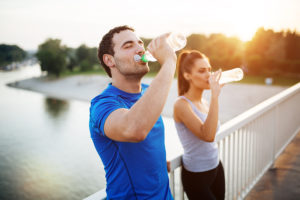 I recently received an email from a friend of mine whose son became dehydrated during a x-country meet. He wanted to know how it could have been prevent, especially since the trip to the hospital cost them $2500. So let’s look at some hydration basics:
I recently received an email from a friend of mine whose son became dehydrated during a x-country meet. He wanted to know how it could have been prevent, especially since the trip to the hospital cost them $2500. So let’s look at some hydration basics:
75% of your body is water
80% of your brain is water
75% of your muscles are water
92% of your blood is water
Hopefully you’re seeing how important water is to your human performance. Add in the fact that water helps to convert food into energy, carries nutrients to all your cells and organs, and helps to regulate your body temperature, the effects of dehydration not only compromises your performance but can have life-threatening consequences.
Hydration Basics – Warning Signs of Dehydration
Before we talk about ways to stay hydrated let’s first look at the effects dehydration can have on your human performance. Here are the warning signs of dehydration:
Noticeable thirst
Lack of focus
Dizziness or light-headedness
Increased fatigue
Weakness
Muscle cramps
Decreased performance
Loss of appetite
Flushed skin
Heat intolerance
Headache
Nausea
And the signs of dehydration can occur fairly rapidly. According to Kendrick Fincher Hydration for Life, it’s estimated that
1% dehydration results in thirst
2% dehydration reduces your ability to work
4% dehydration results in lethargy, apathy, and mental symptoms
Unfortunately, how we feel does not cause most of us to stop what we’ve doing and drink more water. My friend asked me how his son could have prevented this from occurring. And my suggestion to him would be the same to everyone reading this post.
Check your urine color.
If your urine is clear, then you’re most likely well hydrated.
If your urine is pale, then you’re slightly dehydrated.
If your urine is the color of lemonade, then you’re most likely at the 1 to 2% dehydration level and need to take preventative measures.
And if your urine is dark like apple juice, then you’re dehydrated and need to drink water.
Hydration Basics – How Much Water Do You Need to Consume
This is the area that creates the greatest level of confusion as you will find multiple recommendations. Most of these recommendations depend upon your activity level. If you’re active, then you need more water. If you’re active in an environment that causes you to sweat, then you need even more water.
According to the American College of Sports Medicine, active people need at least 16-20 ounces of fluid one to two hours prior to their activity. They recommend 6 to 12 ounces of fluid every 10 to 15 minutes that you’re engaged in your activity. And then another 16 to 24 ounces after your done with your activity.
Unfortunately, most athletes don’t do that because of the need to go to the bathroom. Yet it’s your urine color that will help you determine how to adjust the above recommendation based on your sport and level of intensity.
Another estimation on the amount of water we need to prevent dehydration is based on the number of calories you expend for the day. According to this method you need about 1 mL of water for every calorie burned. If your caloric expenditure is 3000 calories for the day, then you would need to consume 3 liters of water or approximately 13 cups. Give this method here’s a quick guide:
Expend 1000 calories and you need 1 liter or 4 cups of water
Expend 2000 calories and you need 2 liters or 8 cups of water
Expend 3000 calories and you need 3 liters or 12 cups of water
And the best source of fluid to hydrate your body is water. However, some hydration can come from the foods we eat. Just like we’re predominately water so are the fruits and vegetables we eat. If you use sports drinks, then stay away from those that have more than 4 grams (1 teaspoon) of sugar per 8 ounces of fluid. Alcoholic and caffeinated beverages are not recommended since they act as diuretics. So drink these for enjoyment rather than as your primary source of fluids to hydrate you.
My favorite way to keep me hydrated is to add 1 tablespoon of Liquid Chlorophyll to 16 ounces of water. I prefer the taste of this over straight water so I drink more fluids this way. Plus Liquid Chlorophyll helps to detox my system as well as improve my blood chemistry.
Final Thoughts On Hydration Basics
Water is essential for life. It needs to be consumed on a daily basis. The greater your activity level the greater the amount you need to consume. And as I was researching information for this post, I came across an interesting article from the Wellness section of The Washington Post. It had 8 “True or False” statements about proper hydration. If you click here, then you can test your knowledge in this area of hydration basics.
Leave a Reply
You must be logged in to post a comment.